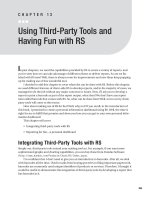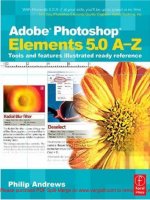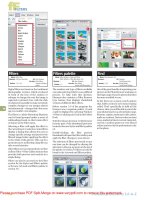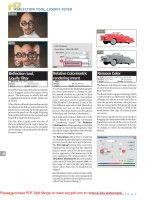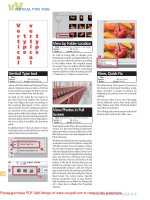09 recovery tools and aids
Bạn đang xem bản rút gọn của tài liệu. Xem và tải ngay bản đầy đủ của tài liệu tại đây (471.34 KB, 13 trang )
UNIVERSITY
Recovery
Tools and
Aids
Ice, Heat, Massage, and
other techniques that may
aid recovery
Lesson Overview
•
•
•
•
•
•
•
•
Cold Therapy
Heat Therapy
Contrast Therapy
Compression Therapy
Massage (deep tissue, ART, Graston, cupping)
ESTIM and EMS
FOAM ROLLING
Other Mentions
Context to Recovery
Recovery Hierarchy:
Manage Training Stress > Sleep/rest/stress > Nutrition > Recovery tools
Following methods are small effect sizes compared to your primary
recovery tools
If training recovery is that poor, address the primary issue TRAINING!
Training must match your recovery capacity
These tools can be expensive but those most effective recovery
strategies are nearly free!
COLD THERAPY
What is it?
Any cold thermal based strategy
How it works?
Blunt inflammatory processes
Vasoconstricting
Can limit hypertrophy adaptations (some inflammation and cytokines important)
Decrease in pain and fatigue perception
TYPES:
• Cold Water Immersion (body submerged to neck, 10minutes, temp 50-54 degrees
F). Can be used acutely for very hard bout of training , but chronically not
recommended.
• Cryotherapy (full body room, 3 minutes, -166 degree F)
• Less effective than cold water immersion
• Limited research in efficacy
• Not time or cost effective
• Localized Cold Therapy (15-20 minute ) Ice packs or cold compress
• Not shown to improve DOMS or improve muscle weakness post training
Recommendation:
Within bodybuilding, limited application for Cold Therapy
Exception within 15 minute of injured area
Hypertrophy primary goal
HEAT THERAPY
What is it?
Any form Heat Treatment (hot compress, heating pad, hot bath)
How it works?
Vasodilation
Increased Oxygenation
Increased Nutrient Delivery and uptake
Removal of localized waste
Physical and mental relaxation
Decreased DOMS and pain perception
Can increase inflammation close to training
Typical regiment:
96-105 degrees F for 20-25 minutes >2 hours post training
Recommendations:
Practical use at home for hot bath and relaxing
Use as needed following training
CONTRAST THERAPY
How it works?
Vasoconstriction + vasodilation
Blood pumping effect
Reduced edema and pain
Decrease in DOMS
May decrease hypertrophy adaptations
How to do it?
1.5-2 hours post exercise
30 min
Hot 96-105 degree F: 5 min hot
Cold 50-68 degree F: 5 min cold
Recommendations:
Highly impractical for most, local tissue is potentially feasible
Ice therapy to impeding on hypertrophy adaptations, limit usage as
needed
COMPRESSION THERAPY
How it works?
Improved blood and lymph flow
Reduced DOMS
Reduced edema
More effective with muscle damaging exercise
What does it do?
Improved strength performance within 24-48 hours
Reduction is creatine kinase post resistance training
How to do it?
Shirts, shorts, pants can be purchased with pressure of ~15-30mmHg
CEP Compression Leggings (Ex: CEP, 2XU, Skins)
Dynamic compression at facilities (ie Compression boots)
Apply 2 hours following training session for 12-48 hours for clothing, 20-30minutes
via Dynamic compression
Recommendations:
More applicable during high training volume periods and contest prep
Clothing is practical to utilize
Compression boots must consider time efficiency vs other modalities
MASSAGE
How it works?
Effect is via relaxation and increase in parasympathetic activity primarily
Most effective for reduction of perception of fatigue
Reduction of DOMS and Creatine Kinase up to 48 to 72 hours post training
greater effect than cold water immersion, compression, and contrast
therapy.
Large contributing factor is relaxation with decreases in cortisol
Social support another benefit
How to do it?
Most studies implement massage within 2 hours post training, but
benefits can be seen up to 72hours post training
Other Notes:
General massage can not remodel soft tissue
Instrument Assisted soft tissue mobilization (IASTM) more efficacious for
tissue remodeling
Recommend:
Massage Therapy by Graston and Active Release Therapy Certified LMT
Minimum once per mesocycle or EW or EOW if able
Vibration Therapy (massage gun) research for similar efficacy as massage
Foam rolling may provide other alternative
ESTIM AND EMS
How it works?
Vasodilation
Inhibit nociceptor signaling (decrease pain)
Increased motor unit firing and muscle contraction
May increase fatigue variables
Neufit:
DC current and EMS machine
Pretraining potential with Neufit and retraining neural firing patterns
Improved range of motion post training
Potential for training with low load and stimulating hypertrophy
Mixed research results on DOMS , no research on Neufit
Recommendations:
Higher cost to entry and research efficacy is low
Neufit therapy anecdotally effective rehab strategy
Low evidence for hypertrophy training recovery tool
FOAM ROLLING
How it works?
Reduction in tissue adherence and stiffness
Analgesic effect
Increased blood flow
Parasympathetic response
What does it do?
Acute improvement in ROM no more than stretching
Pretraining: short term improvement in ROM without performance
decrease *cation: Analyze why ROM is poor to begin with
Post training: slight change in DOMS, but minimal effectiveness
Poor mans self massage?
How to do it?
Roll medial to distal on a muscle for 5 second duration for 30-60 seconds
total, stop on trigger points for 10 seconds then continue rolling
Recommendation:
Rolling “tight spots” pre training effective for ROM without reduction in
performance
Can be utilized post training, but small effects seen in recovery
Other Therapies
Stretching: No effect on DOMS or recovery enhancement, might
increase DOMS
NSAIDS: blunt hypertrophy adaptations and slow recovery process,
mask pain response. Limit usage as needed
Cupping: No evidence to support improved recovery capacity outside
of relaxation, however increased tissue trauma can add fatigue
Float Tanks: Relaxation technique indirect effect on recovery
Active Recovery: No effect of recovery directly, may generate more
fatigue (EX: light cardio post leg training)
Practical Takeaway
• Focus on Primary Recovery Strategies First (sleep, relax, rest, nutrition)
• Techniques that promote relaxation and social support show greatest
benefit
• Limit Ice Therapy to immediate injuries and avoid otherwise
• Hot tub soaks for 20min practical and won’t limit hypertrophy
adaptations. Implement > 2 hours post training. Use as needed.
• Massage work shows greatest efficacy post training recover, potential
benefit for self massage techniques as well. Implement 2-72 hours post
training. For cost consideration, implement during deload phases every
4-8 week or as needed.
• Foam rolling pretraining not detrimental but evaluate if “tightness” is
from poor connective tissue recovery and/or movement dysfunction
patterns. Do NOT force a ROM if the body says NO.
• 2nd most efficacious strategies from massage is a compression garment
worn post training for 2-12 hours. More applicable during contest prep
with heavy cardio work
REFERENCES
Nogueira, N.M., Felappi, C.J., Lima, C.S. et al. Effects of local cryotherapy for recovery of
delayed onset muscle soreness and strength following exercise-induced muscle damage:
systematic review and meta-analysis. Sport Sci Health 16, 1–11 (2020).
/>Wilke, J., Müller, A., Giesche, F. et al. Acute Effects of Foam Rolling on Range of Motion in
Healthy Adults: A Systematic Review with Multilevel Meta-analysis. Sports Med 50, 387–402
(2020). />
Brown F, Gissane C, Howatson G, van Someren K, Pedlar C, Hill J. Compression Garments and
Recovery from Exercise: A Meta-Analysis. Sports Med. 2017;47(11):2245-2267.
doi:10.1007/s40279-017-0728-9
Abaïdia AE, Lamblin J, Delecroix B, et al. Recovery From Exercise-Induced Muscle Damage:
Cold-Water Immersion Versus Whole-Body Cryotherapy. Int J Sports Physiol Perform.
2017;12(3):402-409. doi:10.1123/ijspp.2016-0186
Dupuy O, Douzi W, Theurot D, Bosquet L, Dugué B. An Evidence-Based Approach for
Choosing Post-exercise Recovery Techniques to Reduce Markers of Muscle Damage,
Soreness, Fatigue, and Inflammation: A Systematic Review With Meta-Analysis. Front
Physiol. 2018;9:403. Published 2018 Apr 26. doi:10.3389/fphys.2018.00403
Hauswirth C, Mujika, I. Recovery for Performance in Sport. Champaign, IL: Human Kinetics;
2013.
